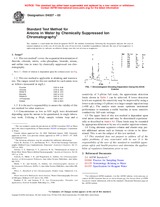Wir benötigen Ihre Einwilligung zur Verwendung der einzelnen Daten, damit Sie unter anderem Informationen zu Ihren Interessen einsehen können. Klicken Sie auf "OK", um Ihre Zustimmung zu erteilen.
ASTM D4327-03
Standard Test Method for Anions in Water by Chemically Suppressed Ion Chromatography
Automatische name übersetzung:
Standard Test Method for Anionen in Wasser durch chemische Suppressions-Ionenchromatographie
NORM herausgegeben am 10.1.2003
Informationen über die Norm:
Bezeichnung normen: ASTM D4327-03
Anmerkung: UNGÜLTIG
Ausgabedatum normen: 10.1.2003
SKU: NS-26853
Zahl der Seiten: 9
Gewicht ca.: 27 g (0.06 Pfund)
Land: Amerikanische technische Norm
Kategorie: Technische Normen ASTM
Die Annotation des Normtextes ASTM D4327-03 :
Keywords:
anions, drinking water, ion chromatography, reagent water, wastewater, ICS Number Code 71.040.40 (Chemical analysis)
Ergänzende Informationen
| Significance and Use | |||||||||||||||||||||
|
Ion chromatography provides for both qualitative and quantitative determination of seven common anions, F−, Cl−, NO2−, HPO4−2, Br−, NO3−, and SO4−2, in the milligram per litre range from a single analytical operation requiring only a few millilitres of sample and taking approximately 10 to 15 min for completion. Note 2—This test method may be used to determine fluoride if its peak is in the water dip by adding one mL of eluent (at 100× the concentration in 8.3) to all 100-mL volumes of samples and standards to negate the effect of the water dip. (See 6.3, and also see 6.4.) The quantitation of unretained peaks should be avoided. Anions such as low molecular weight organic acids (formate, acetate, propionate, etc.) that are conductive coelute with fluoride and would bias fluoride quantitation in some drinking waters and most wastewaters. Anion combinations such as Cl−/Br− and NO2−/NO3−, which may be difficult to distinguish by other analytical methods, are readily separated by ion chromatography. |
|||||||||||||||||||||
| 1. Scope | |||||||||||||||||||||
|
1.1 This test method covers the sequential determination of fluoride, chloride, nitrite, ortho-phosphate, bromide, nitrate, and sulfate ions in water by chemically suppressed ion chromatography. Note 1Order of elution is dependent upon the column used; see . 1.2 This test method is applicable to drinking and wastewaters. The ranges tested for this test method for each anion were as follows (measured in mg/L):
1.3 It is the user's responsibility to ensure the validity of this test method for other matrices. 1.4 Concentrations as low as 0.01 mg/L were determined depending upon the anions to be quantitated, in single laboratory work. Utilizing a 50-μL sample volume loop and a sensitivity of 3 μS/cm full scale, the approximate detection limits shown in Table 1 can be achieved. If lower detection levels are required, the sensitivity may be improved by using a lower scale setting (< 3 μS/cm) or a larger sample injection loop (>100 μL). The analyst must assure optimum instrument performance to maintain a stable baseline at more sensitive conductivity full-scale settings. 1.5 The upper limit of this test method is dependent upon total anion concentration and may be determined experimentally as described in Annex A1. These limits may be extended by appropriate dilution or by use of a smaller injection volume. 1.6 Using alternate separator column and eluents may permit additional anions such as formate or citrate to be determined. This is not the subject of this test method. 1.7 This standard does not purport to address all of the safety problems, if any, associated with its use. It is the responsibility of the user of this standard to establish appropriate safety and health practices and determine the applicability of regulatory limitations prior to use. |
|||||||||||||||||||||
| 2. Referenced Documents | |||||||||||||||||||||
|
Empfehlungen:
EEviZak – alle Gesetze einschließlich ihrer Evidenz in einer Stelle
Bereitstellung von aktuellen Informationen über legislative Vorschriften in der Sammlung der Gesetze bis zum Jahr 1945.
Aktualisierung 2x pro Monat!
Brauchen Sie mehr Informationen? Sehen Sie sich diese Seite an.




 Cookies
Cookies
